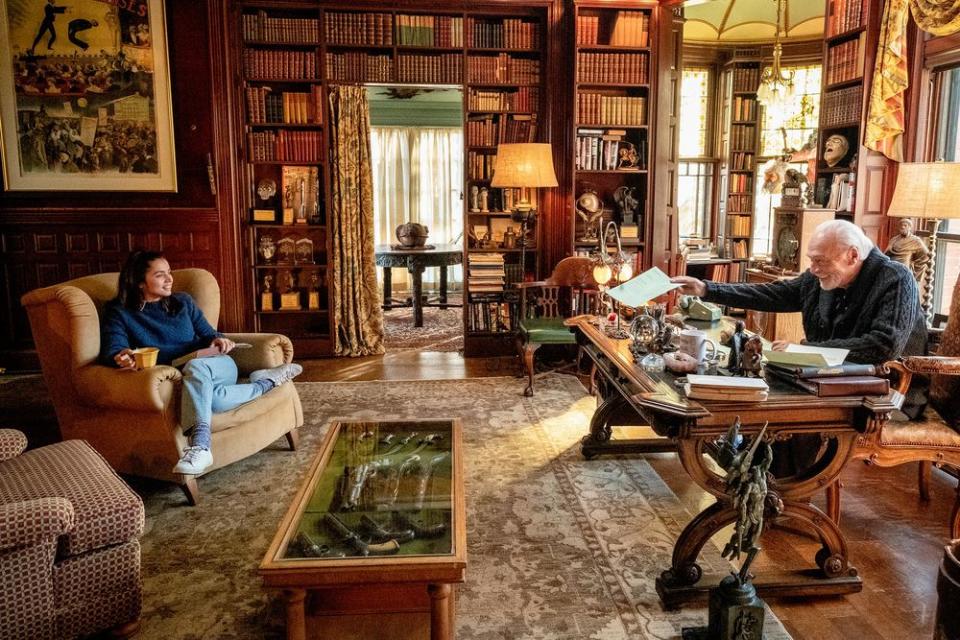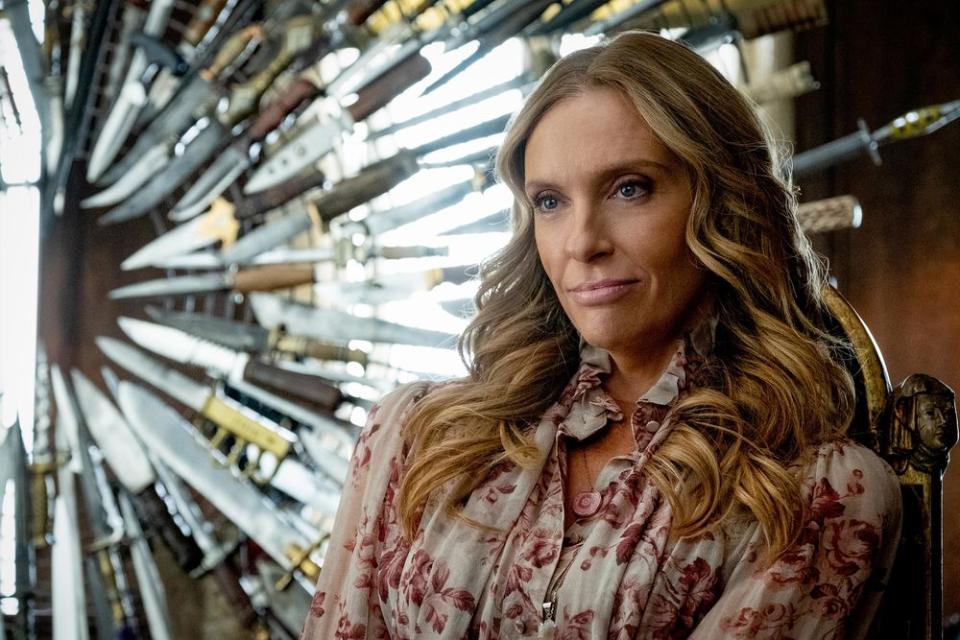Knives Out production designer on that crazy house, and which details you might have missed
Rian Johnson’s modern take on a classic whodunit, Knives Out, features one of the most star-studded casts of the year, but there’s another major character in the film that isn’t of the flesh-and-blood variety: the Thrombey estate.
In the film, the New England manor belongs to mystery novelist Harlan Thrombey (Christopher Plummer), and it’s where the majority of the action — including the central mystery surrounding Thrombey’s death — unfolds. The home is filled with all sorts of kooky odds and ends befitting of an eccentric writer, including weird sculptures, massive self-portraits, and a giant circle of knives.
In real life, the home is a Massachusetts estate that has belonged to the same family for more than 100 years, lovingly preserved and barely altered. Ahead of the film’s premiere, Knives Out production designer David Crank spoke with EW about finding the right house, that unforgettable knife display, and the weirdest props you probably didn’t notice (murder scene dioramas, anyone?).
ENTERTAINMENT WEEKLY: What were your initial conversations with writer-director Rian Johnson like, and how did you go about finding that house?
DAVID CRANK: When I started, Rian and a producer had looked at this home one or two months before. And when I came on, we looked at some others just so we’d have options, but we kept going back to this one. It was a little over 100, 120 years old and it had been lived in by the same family the entire time, and they hadn’t really ever altered it terribly. They kind of updated it, but they hadn’t changed it. So it still had all of the great-grandfather’s things in it. So the house had a huge amount of personality just on its own. And when Rian and I first talked, the biggest thing that he had to say was that the house was a reflection of the writer’s mind, and that’s the strongest piece of advice he gave me, and we kind of went from there.
Did you pull from any particular films or shows for inspiration?
Well, we did watch Sleuth, that was one that Rian wanted me to watch from the beginning. There were things about that that we liked, that we used as a reference. I think that was one that had a display of the guy’s books in the background. But the script was so wonderful. And from the script you got to pick those things, kind of build them yourself, which was a lot of fun. But we really considered each thing separately, we weren’t trying to lift directly from [another work].
Did you have to build any part of the house?
We used the first floor of the house and the exterior, and then we built the second floor and the third floor on the stage, because there were issues of the size of the hallways and stuff upstairs. It wasn’t easy to get a company up to it. And then we kind of based [the new floors] on the architecture of the house and kind of ran with it, so it got kind of crazier as you went up each floor.
What was the hardest of the house’s odds and ends to source?
I don’t know that there was any one thing. We made a lot of things. And often we’d find something interesting, and then that would kind of spark another thing. For instance, there’s a bar in the study scene. That was a giant dollhouse that set decorator David Schlesinger had found, and we didn’t know what to do with it, but it was too good of a price to pass up. You know, from that, we then made it into a bar. It was a very corporate thing to do with a child’s toy. [Laughs]
I have to ask about that giant display of knives. How did that come about?
It was in the script that there was a knife display, but it didn’t really describe it very much. And so it was a thing that grew out of conversations and making different prototypes. And we were having trouble because we didn’t really know exactly how we wanted to use it, because it wasn’t really stated in the script, from what I remember. Rian one time described it to me as a score. And that’s kind of when the idea took shape, but I can’t take total credit for it.

The house has so much going on in it, but what’s one detail of the set that maybe the audience wouldn’t necessarily notice but that you just love?
The art director [Jeremy Woodward], one of his projects was figuring out the entire canon of [Harlan Thrombey’s] work from decade to decade to decade, like four decades’ worth. And he designed the settings of how each of the book jackets looked, and how they changed from decade to decade. And they were just kind of around, there wasn’t one big display of them, but it was that kind of detail we got to figure out. So, beyond one special thing, it was just that we had enough time that we were able to add a lot of things like that that built [Harlan’s] character, and trying to reflect his mind in this house.
What was the absolute weirdest thing that was created for the house?
One thing that David Schlesinger and his crew kind of made which was quite fun, was we had these dioramas that were in the library, and they were [portraying] terrible little murder scenes. They weren’t [part of the plot] so much as things that were used to kind of fill out Harlan’s personality and his interest in mystery crime writing, but those were quite fun.
This isn’t a question so much as it is an observation, but the film definitely portrays the house as if it’s its own character.
Yeah, I think that was very much thanks to Rian. I mean, it’s interesting when you have that much of a movie happening in one place. It’s got to take on a life of its own or it will get boring really fast. So you really need to make sure that it was always active and interacting with people in the film. It has to be as much a part of them as the background.

Knives Out, which stars (deep breath!) Plummer, Chris Evans, Jamie Lee Curtis, Daniel Craig, Michael Shannon, Ana de Armas, Toni Collette, LaKeith Stanfield, and more, is in theaters now.
This interview has been edited for length and clarity.
Related content:

